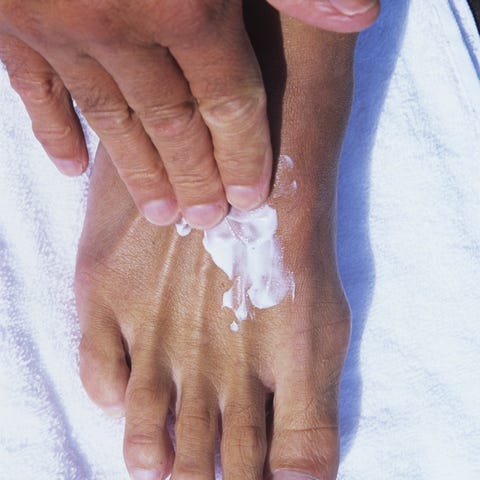Two-Thirds of Sunscreen Products Basically Suck
Summer’s hot, and the debate over how to protect yourself from the sun is even hotter. The Environmental Working Group released its 2019 Guide to Sunscreens today—the 13th annual report of its kind—and it finds that two-thirds of sunscreen products on the market “offer inferior protection or contain worrisome ingredients.” But not everyone agrees you should be scared.
The report rates the safety and efficacy of more than 1300 sun-protection products, including sunscreens, moisturizers, and lip balms. “Just under 60 percent of the products we assessed contain ingredients that the FDA says they don’t have enough toxicology data to state if they’re safe and/or effective,” says Nneka Leiba, director of EWG’s Healthy Living Science program.
The FDA created a proposal for new sunscreen regulations in February of this year. “Their recommendations strongly align with what we’ve been recommending for 13 years,” Lieba says. “If they went through as written, they would absolutely move our sunscreen market into where it should be,” she says. “The fact that 12 of the active ingredients we use almost every day don’t have enough toxicology data is appalling.”
Among the EWG’s concerns:
Not all experts agree
But some dermatologists think the chemical sunscreen concerns are overblown. And they point out that the JAMA study published in May—the one that found sunscreen chemicals in the blood of people who applied chemical sunscreens four times a day for four days—likely created more panic than scientific advancement.
“How it was interpreted was, ‘OMG, it gets in the blood and it’s going to kill us all!’” says Adam Friedman, M.D., professor and interim chair of dermatology at George Washington School of Medicine and Health Sciences, who says he gets questions about it all the time. But take a closer look at the study, and you’ll see that each group in the study had only six participants, he says. And people applied the chemicals “optimally,” meaning, applied them like you’re supposed to, which is 2 milligrams per square centimeter of skin—“which never happens in real life,” says Dr. Friedman. “They did find an increase in serum blood levels, but they created an arbitrary cutoff point that was exceedingly low—it was a billionth of a gram per milliliter of blood.” While the study shows it does get in the blood when used optimally, “we need to understand what that means.”
And maybe it doesn’t mean a lot. “I can see that people would infer that it gets into your blood and there’s a danger there,” he says. But there’s not enough evidence to say that there is a danger. In fact, the FDA’s proposed regulations state that 12 of those chemical ingredients have “insufficient data” to determine if they’re Generally Recognized as Safe and Effective (GRASE), so it’s calling for additional data.
Plus, a paper published in the Archives of Dermatology in 2011 calculated that it would take 277 years of daily sunscreen use to get to the levels of oxybenzone found to have negative effects in certain rat studies.

Hill Creek PicturesGetty Images
So is “wear sunscreen” still smart?
Yes. While there aren’t confirmed answers about whether chemical sunscreen ingredients are harmful yet, there’s no doubt that sunlight is—it is actually a known carcinogen. Nobody we spoke with, including the EWG, is saying don’t use sunscreen (although there is a small group of scientist doubters out there).
“There’s clear evidence that excess sun exposure can lead to skin cancer. Skin cancer incidence continues to rise. There is also clear evidence that sun protection reduces the risk of skin cancer,” says Men’s Health dermatology advisor Adnan Nasir, M.D., Ph.D. In other words, “the hazards of excess sun exposure are clear. The benefits of sun protection are clear. The hazards of currently available sunscreen are not clear, and the doses miniscule for most people.”
Which sunscreen products should you use?
Make sure whatever you’re using says on the label that it provides “broad spectrum” protection. Remember that SPF numbers only apply to the blockage of UVB rays, the ones that can burn you. You also need protection from UVA rays, which can be much sneakier, because you don’t know you’re getting them. Mineral sunscreens hinder both UVA and UVB, and so do many chemical products.
In fact, says Dr. Friedman, chemical filters often have synergy, “so if you have an SPF of, say, 3 of avobenzone and an SPF of 5 of octinoxate, it ends up being an SPF of 12 because of the way they work. I encourage people to use a product that has multiple filters, because they have synergy, and that also means they’re using less of each one.” And whatever you do, don’t follow the dangerous trend of trying to make your own.
Remember that “sun protection can take many non-chemical forms,” says Dr. Nasir. That means “limiting outdoor hours during peak sun, seeking shade, and wearing sun-protective clothing, hats, and sunglasses.”
Of course, derms recommend sunscreen even if you’re in the shade. If you want to be cautious about what you apply, keep in mind that a full third of the sunscreens the EWG looked into did meet their standards, including many non-mineral options and many options offered by popular brands. Find the group’s top-rated sunscreens (and the entire report) here.
Source: Read Full Article




